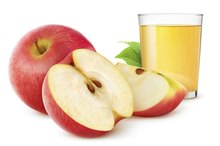Is Cranberry Juice Acidic or Alkaline?
With the exception of pure water, which is neutral, all food is either acid-forming or alkaline-forming when metabolized in the body. Consuming a diet that emphasizes alkaline-forming foods over acid-forming foods helps support a balanced body pH, or the state of homeostasis necessary for bodily function and optimal health. Many highly acid-forming foods, such as baked goods and processed foods, supply little more than empty calories while temporarily increasing the body's acid load. Other slightly to moderately acid-forming foods, including most nuts, many whole grains and a few fruits, are nutrient-dense, health-promoting components of a balanced diet.
Acid Content
Cranberries are rich in quinic acid and contain significant amounts of malic and citric acids. This high acid content translates to a low pH — freshly extracted, unsweetened cranberry juice is valued between 2.3 and 2.5 on the pH scale, depending on the fruit’s state of ripeness. Comparatively, fresh lemon juice is similarly acidic, with an average pH of 2.3. Fresh lime juice is slightly more acidic, valued between 1.8 and 2.0, and fresh grapefruit juice is slightly less acidic, with a pH value of 3.0. The freshly extracted, unsweetened juices of oranges and pineapples are less acidic among the common fruit juices, each having a median pH value of about 3.6.
- Cranberries are rich in quinic acid and contain significant amounts of malic and citric acids.
- This high acid content translates to a low pH — freshly extracted, unsweetened cranberry juice is valued between 2.3 and 2.5 on the pH scale, depending on the fruit’s state of ripeness.
Metabolic Process and pH
Foods That Turn to Acid When You Eat Them
Learn More
A food’s acid content doesn’t determine whether it becomes acid or alkaline forming — its pH nature in the body is a product of the metabolic process. Often, a food's acid content contrasts its effect in the body. For example, whole eggs are alkaline, but they’re moderately acid-forming in the body. Similarly, chocolate cake has an alkaline pH, but is highly acid-forming in the body. Angel food cake and watermelon have a comparable, slightly acidic pH range of about 5.2 to 5.6. In the body, however, watermelon is highly alkaline-forming, while angel food cake is highly acid-forming. Most citrus fruits are acidic, but have an alkaline effect in the body. Cranberry juice itself is very acidic, but it’s only moderately acid-forming in the body.
- A food’s acid content doesn’t determine whether it becomes acid or alkaline forming — its pH nature in the body is a product of the metabolic process.
- Similarly, chocolate cake has an alkaline pH, but is highly acid-forming in the body.
Alkaline-Forming Fruits
Most fruit is alkaline-forming in the body. Cranberries, dates, plums, pomegranates and prunes are the exceptions — all are slightly to moderately acid-forming. Cranberries, plums and prunes are acid-forming in the body because the types of acids they contain convert to hippuric acid in the liver, which cancels out the alkalizing effects of the sodium, magnesium and potassium present in these fruits. All of the most alkaline-forming fruits contain high to moderate amounts of acids, but these acids don’t negate the effects of the alkalizing compounds. Highly alkaline-forming fruits include watermelon, cantaloupe, honeydew melon, papaya, mangoes, figs, kiwi fruit, lemons, limes, pineapple, apples, blackberries, strawberries, raspberries, peaches, apricots, pears, oranges, tangerines and bananas.
- Most fruit is alkaline-forming in the body.
- Cranberries, plums and prunes are acid-forming in the body because the types of acids they contain convert to hippuric acid in the liver, which cancels out the alkalizing effects of the sodium, magnesium and potassium present in these fruits.
Considerations
Foods High in Glucaric Acid
Learn More
Cranberry juice is useful in preventing urinary tract infections because cranberries contain proanthocyanidins, or PACs, which prevent bacteria — including E. coli, the bacteria responsible for up to 90 percent of urinary tract infections — from adhering to and infecting the urinary tract.
Adding sugar to cranberry juice cuts its acidity by increasing its pH value because the pH of refined sugar is much less acidic than that of cranberry juice. However, adding sugar to cranberry juice makes the juice highly acid-forming in the body because sugar is highly acidifying. Instead, cut the acidity in cranberry juice with unsweetened apple cider or unsweetened apple juice, both of which are alkaline-forming.
- Cranberry juice is useful in preventing urinary tract infections because cranberries contain proanthocyanidins, or PACs, which prevent bacteria — including E. coli, the bacteria responsible for up to 90 percent of urinary tract infections — from adhering to and infecting the urinary tract.
- However, adding sugar to cranberry juice makes the juice highly acid-forming in the body because sugar is highly acidifying.
Related Articles
References
- “Encyclopedia of Healing Foods”; Michael Murray et al.; 2005
- “Acid Alkaline Food Guide”; Dr. Susan Brown et al.; 2006
- “The pH Balance Diet”; Bharti Vyas et al.; 2007
- “Alkalize or Die”; Dr. Theodore Baroody; 1991
- Oklahoma State University: The Importance of Food pH in Commercial Canning Operations
Writer Bio
Based just outside Chicago, Meg Campbell has worked in the fitness industry since 1997. She’s been writing health-related articles since 2010, focusing primarily on diet and nutrition. Campbell divides her time between her hometown and Buenos Aires, Argentina.









